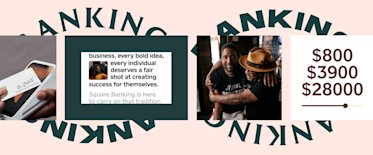In July, Square introduced Square Banking, a suite of products aimed at helping small businesses sell, save, spend, and borrow — all in one place. To add to the excitement, it’s the first time in 10 years the FDIC has granted a bank charter.
Not surprisingly, launching a bank isn’t easy. In addition to building the product (which, by the way, is no small feat in itself), there’s also the creative surrounding the launch and promotion. This includes landing pages, email, launch and demo videos, social media posts — and, yes, an identity for Square Banking.
Leading the charge were two creative directors, Mad (design), whose passion for helping shape digital brands stems from her experience at Lyft and in agencies, and Vickie (copy), whose background in journalism influences the way in which she helps digital brands craft their content and narrative. I was lucky enough to sit down with both of them to discuss their thinking, creative strategy, and process behind the launch.
What makes Square Banking unique and different from other companies in the financial industry? And how do we communicate this to our audience?
M: At the end of the day, it’s a financial product. But from a brand and visual standpoint, how do you bring in unconventional energy but keep a balance of trust and seriousness that a financial product needs? We know our small business owners are creators and entrepreneurs, so while finance is a serious subject, our brand should carry through the same creative energy and bold confidence small businesses owners embody. Finance doesn’t have to be boring.
V: So this means not just having a solid product offering, but also talking differently and looking different — but still maintaining the professional, trustworthy look and feel you expect from a financial institution at the same time.
The way we talk about banking, its products, and how to use the products is just as important as the banking products themselves. People need to feel comfortable enough to actually use the products and understand what’s going on.
M: Our goal is not just to make people interested in learning more about our product offerings, but also get them to be more comfortable making financial decisions. And so our design approach has been embracing the text-heavy nature of financial brands. We avoid having fine print everywhere and use interesting type treatment to make our terms a part of our contents, and make paragraphs more conversational and digestible.

V: I think there’s something to be said about visual hierarchy as well. The design team here has done a really great job at elevating the right info at the right size at the right moment. It sounds so simple but it makes for a much easier experience on your eyeballs — and makes for a less scary experience when you’re going through rows and rows of financial information for products that you don’t know if you want to use yet.
M: Being bold doesn’t always mean being kooky or hitting people over the head with the message. For us, being bold simply means we’re confident enough in our suite of products that we can strip out unnecessary, mysterious jargon.
Did Square’s philosophy of simplicity and ease of use influence the way in which you approached the creative? If so, how?
M: Definitely. Square’s philosophy of simplicity and ease of use is a form of elegance we seek as a foundation to build on. On a product level, that’s the core principle of our Banking products; on the conceptual level of how we execute our ideas, layout, storytelling, we aim to keep things neutral, true to the reality, and not overly dramatize anything. Simplicity is not just an aesthetic, it’s also about identifying what is most important to our sellers and prioritizing it accordingly.

What was the thought behind casting real sellers in the Square Banking launch videos?
V: We very purposely made this decision as a group to cast real sellers because we wanted to showcase the unscripted energy and moments you just aren’t able to replicate with an actor or actress.
M: We basically didn’t know what we were getting into. (Haha…)
V: The savings video, in particular, had a few ideas of key scenes and actions we wanted to capture, but for the most part, that video crew was very fluid with sellers day-to-day because we were hoping for a realistic, accurate portrayal of what they do. We wanted to make sure we’re showcasing our sellers as our authentic brand voice versus using something artificial.
M: Finance is often intimidating to talk about, or not shared among other businesses. We figured that by getting real sellers to share about their relationships and experiences with money, the more we do it, then we can slowly help influence the perception of finance and money.
The Banking launch showcases many Square customers — in the videos, but also on the website and in email. What do you look for when featuring businesses? What makes a successful customer story?
M: I honestly believe that every business owner has a story to tell — maybe some stories are more personal than others. I’ll have to admit that visual elements have a place in the decision-making process as well. As we’re looking to tell a more unpolished, authentic story, we’re looking for the same rich characteristics visually, too. We also try to feature two or three businesses in one video, so how they balance each other out is another consideration.
V: We knew we of course wanted to have representation from across different industries, ethnic backgrounds, gender, etc., but we also wanted diversity in thought and experience as well. Our sellers featured really, really range: From a true, run-from-home family business with Bhangra Empire (complete with cats and babies) to something more established like Red Bay Coffee, which is an amazing business out of Oakland, California, with multiple locations, products in retail stores, and more.
Throughout 2020, I saw a lot of brands call out small business, but these had a more sentimental tone. How did you choose to portray customers, and was it intentionally different from this tone?
V: When we set out to make this video, we knew what we didn’t want: a sad, downtrodden portrayal of entrepreneurship — the difficulties of owning and running a business, and all of the various hardships sellers may have to face. Business owners are, and always have been, a resilient, remarkable group of people. We should celebrate that.
M: There’s a difference between emotion and being emotional. We want our audience to resonate with the videos, but not necessarily feel emotional about it. It’s a moment to celebrate their contributions to both the economy and their community. In a very real way, and not overly saturated in emotion.
We worked with many partners to help bring seller stories to life. Can you share your experience, and speak to this process?
M: Both directors we chose to work with, Geoff Levy (banking) and Eric Wolfinger (savings), are very familiar with the space of small businesses or entrepreneurs.
The actual process involved hours of open conversations between our teams, the directors, and the sellers. It’s crucial for all three parties to understand each other’s visions, strengths, expectations, and all that.
V: I think what was really cool about both Geoff and Eric was that once they understood the different banking products, they were like, “Oh, these are game changers.” They recognized right away the potential implications that products like this can have on the day-to-day for a seller. That was a really cool moment to witness and really important to the storytelling process.
We’re also really fortunate to have researchers who sit on the creative team directly, and so we get a lot of great access to research and interviews with sellers that really have been illuminating for us to learn from: What our sellers are looking for, how they talk, how they feel. That research has been priceless. We would have been grasping our way through the dark if it wasn’t for a solid foundation in research.






